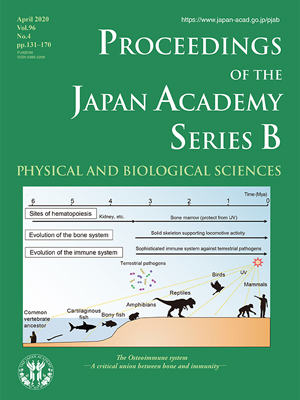About the Cover
Vol. 96 No. 4 (2020)
The principal role of bone is to provide the postural support of the body and to serve as the reservoir of mineral, while that of the immune system is to protect the host against pathogens. It is interesting to point out that the bone and adaptive immune systems developed synchronously during vertebrate evolution. The skeletal system developed when vertebrates moved from the sea onto the land, where terrestrial animals had to cope with the higher gravity compared with marine animals, and cover calcium supply during starvation or periods of deprivation of nutritional calcium supply. Vitamin D and parathyroid hormone, which regulate calcium mobilization from bone, also appeared in vertebrates. Almost simultaneously, the plethora of terrestrial pathogens promoted the development of sophisticated immune systems in the terrestrial animals.
Although these two systems appear to play quite different and independent biological roles, they have close relationship in fact: the immune system affects bone metabolism in pathological conditions such as rheumatoid arthritis and periodontitis, and the bone provides the suitable microenvironments (or niches) that support the development of immune cells and hematopoietic cells. Such an intimate relationship between bone and immune systems inevitably led to the development of this interdisciplinary research field, “osteoimmunology”, which seeks to elucidate the mechanism underlying the interaction between these two systems.
The finding of RANKL (receptor activator of nuclear factor κB ligand) was undoubtedly one of the most important driving forces for the development of osteoimmunology. RANKL was originally identified as a membrane-bound cytokine that is produced by activated T cells and prolongs the survival of dendritic cells. Subsequent studies demonstrated that RANKL is an essential cytokine for osteoclast differentiation, which is produced by osteoblasts in response to calciotropic hormones, and hereby plays a critical role in bone marrow cavity formation and calcium homeostasis.
A recent remarkable advance in osteoimmunology field is reviewed in the article by Hiroshi Takayanagi in this issue (pp. 159-169), who has made a seminal contributions to the evolution of this research field. It is notable that this year marks the 20th anniversary of osteoimmunology, and this field has become increasingly important for both basic understanding of inter-organ relationships and the clinical applications for multiple diseases related to bone and the immune system.
Sakae Tanaka
Professor, Graduate School of Medicine, The University of Tokyo




